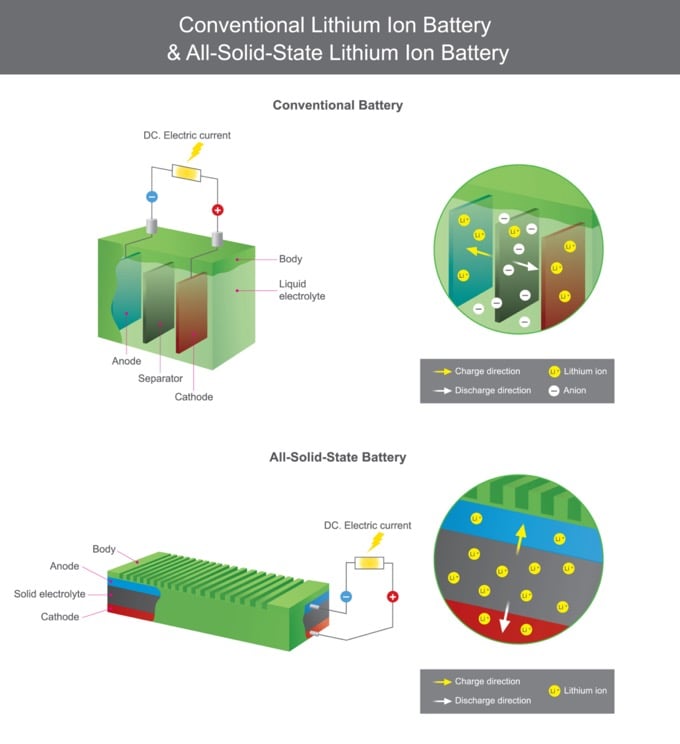Learn all about tomorrow's technology today
Battery technology has come a long way over the years. Gadgets like drones and smartphones would be impractical without advanced modern battery technology.
However, batteries could always be better!
Solid state batteries seem to be the next big advancement and products that use them are around the corner. This means now is the perfect time to familiarize yourself with what they are and why they’re important.
What Does “Solid State” Mean?
Whether it’s a lead acid car battery, alkaline disposables, or lithium polymer batteries in a phone, they all use a liquid electrolyte. The electrolyte is a conductive substance that connects the two internal terminals of the battery. Electrons flow through the electrolyte, allowing the battery to either build up an electrical charge or to discharge it.
A solid state battery uses a solid electrolyte, instead of the traditional liquid electrolyte. That’s the only fundamental difference between the two battery technologies. It sounds simple enough, but engineers and scientists have been struggling for decades to come up with a solid material that can act as an electrolyte.
What’s Hard About Solid State Batteries?
Various materials, such as ceramics and lithium metals, offer potential as solid state electrolytes. The problem is that the ceramic approach has resulted in poor battery performance. Lithium metals are promising, but have a fatal flaw. As the battery is charged and discharged, metal “dendrites” grow through the electrolyte. The battery can short-circuit and turn into a hazard.
Finding practical and economically viable solutions to these issues has been the mission of several companies and research teams over the past few years. Now that work is about to pay off.
Why go through all this trouble? Let’s look at the benefits that solid state batteries promise over traditional ones.
Safety
Batteries store large amounts of energy and there’s always a danger that this energy can be released in an uncontrolled way. When that happens, it can mean fire, explosions and other unwanted outcomes. Solid state batteries, assuming the dendrite issue is resolved, promise to be safer and more stable. For one thing, they aren’t flammable, so battery fires should be a thing of the past.
This is not only important for electric vehicles such as cars and drones, but also for personal electronics such as smartphones and laptops. Many people are injured every year by battery fires in their electronic gadgets. Entire houses have been burned to the ground as a result!
Recharge Speed
Modern lithium batteries can charge at impressive speeds, but they still take a long time to fill up. There’s a limit to how much energy you can pour into a traditional lithium ion battery before it all goes sideways. Solid state batteries promise to charge as much as six times faster than the batteries we currently use. That means charging up your phone from empty to full in five minutes or charging an electric car to 80% in 15.
Energy Capacity and Size
Lithium ion batteries currently have the highest energy density of any battery type sold to the public. Yet it’s still many times less dense than gasoline. While solid state batteries don’t bring batteries up to par with gas, it does promise to more than double the energy density per volume.
In other words, if you changed the battery in your phone using a solid state model, it could theoretically run twice as long without increasing in size. This is yet another big selling point for electric vehicles, which aren’t as popular as they could be, thanks to range anxiety.
Lifespan and Durability
Most current lithium ion batteries start to degrade after about 500 full charge-discharge cycles. After that point the battery begins to lose its capacity until it can barely hold a charge at all. In smartphones, which now tend to have sealed batteries, this puts a hard limit on device lifespan. Solid state batteries promise to greatly increase that limit. As much as five times.
So, where a typical daily-use phone battery might start to degrade after two to three years, a solid state battery would remain at its rated capacity for up to fifteen years. In electric cars, where the replacement of batteries is extremely costly, that could have a dramatic effect on the cost of ownership for this class of vehicles.
Solid State Battery Weaknesses
If this all sounds too good to be true, there are a few caveats to the technology. Some of these still need to be solved before widespread adoption of solid state battery technology is achieved.
- Cost is perhaps the greatest foe. Research teams and startup companies are working hard on making the production process for these batteries cheaper and scalable. Some companies claim to be close, but we won’t know how successful they’ve been until we see the actual prices on products with these batteries.
- These batteries also struggle at low temperatures. Therefore, solutions that involve insulating them or keeping them at a good operational temperature are part of the challenge.
When Can You Buy Solid State Batteries?

There are a few companies like Solid Power and QuantumScape, which claim to be at the cusp of commercial solid state battery applications.
Toyota plans to have solid state battery electric vehicles for sale as early as 2021. Both Solid Power and QuantumScape are aiming for a rollout of batteries for vehicles in 2022 and 2024 respectively. This means that in the next couple of years we could be right at the start of a battery revolution.
That’s before we even get into the possibilities that come from using graphene. This wonder material promises even better batteries, whether they have liquid or solid electrolytes in them. Getting graphene to play ball has eluded scientists and engineers for longer than expected, but you can already buy a hybrid graphene powerbank right now. Truly, the future is here.







